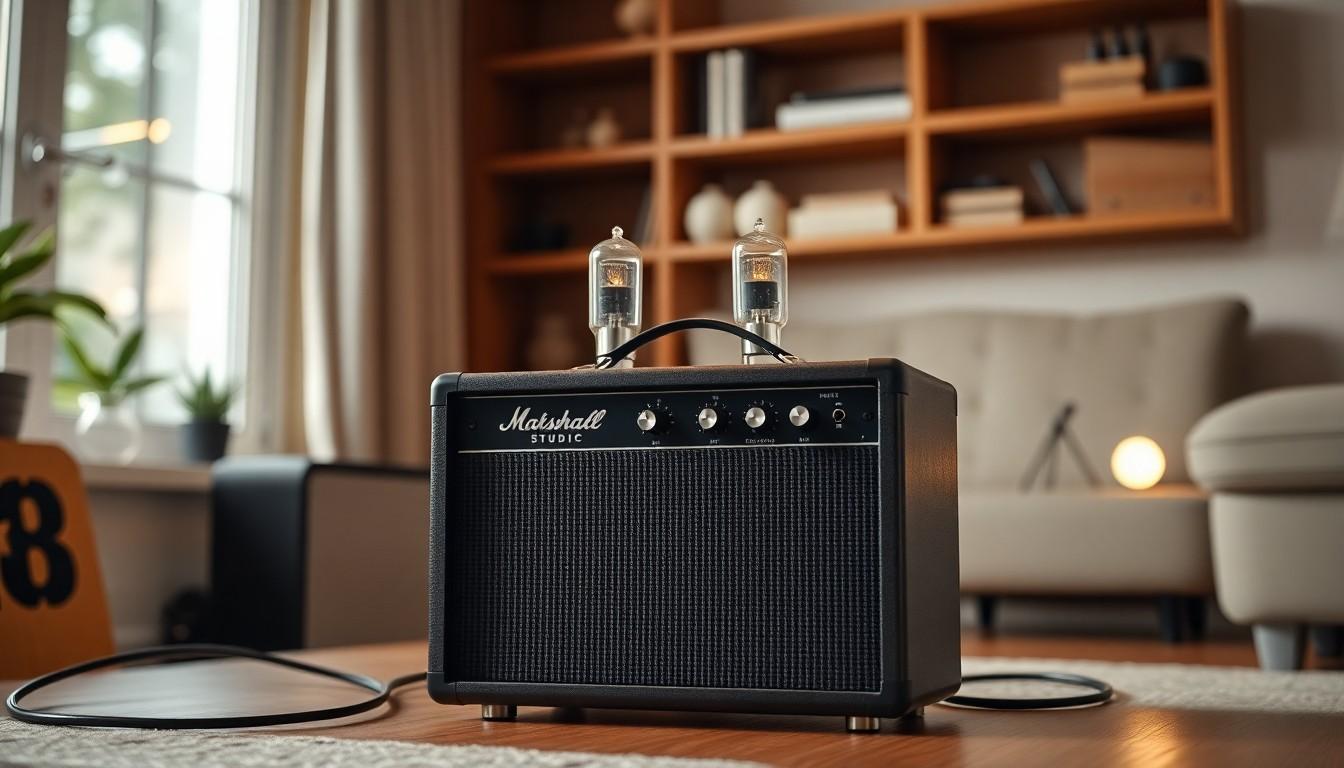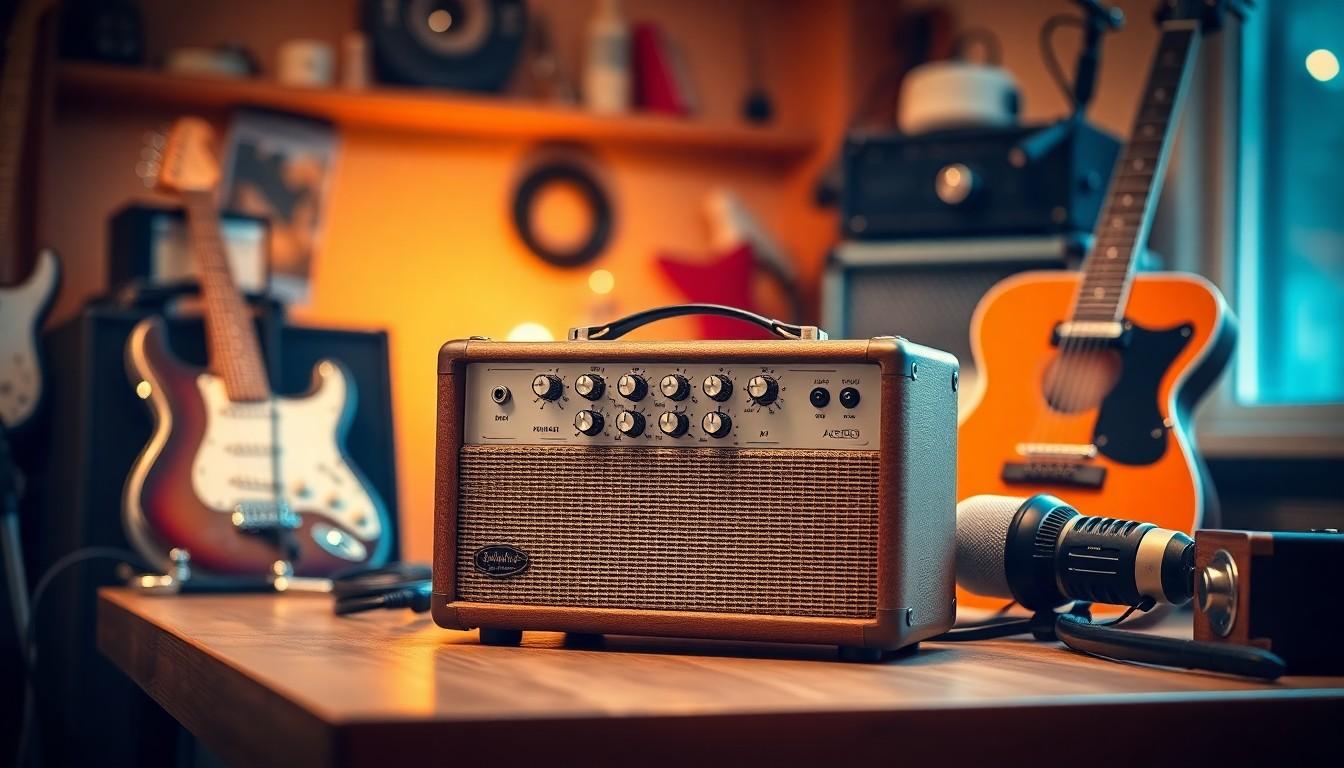Imagine packing the warmth of classic tube tones into a compact design that fits right on your desk. Small tube amps are revolutionizing how musicians and audiophiles experience rich, authentic sound without the bulky footprint.
Whether you’re jamming in your bedroom or enhancing your home studio setup, these nifty amps deliver impressive performance with a dash of vintage charm. Combining modern technology with timeless tube characteristics, small tube amps prove that great sound doesn’t have to come in a large package. Dive in to discover how these powerful little devices can elevate your audio game effortlessly.
Small Tube Amp
Small tube amps deliver exceptional audio quality in a compact form. They integrate classic tube circuitry with modern design, ensuring rich and warm sound reproduction. Typically weighing between 10 to 30 pounds, these amps are ideal for home studios and personal use. Manufacturers prioritize portability without compromising tonal integrity. For instance, brands like Fender and Marshall offer models that maintain vintage tones in smaller sizes. Users appreciate the ease of setup, as many small tube amps feature built-in effects and versatile connectivity options. Additionally, advancements in technology enhance durability and efficiency, allowing these amps to deliver consistent performance. The power output ranges from 5 to 30 watts, suitable for various applications from recording to live performances. A markdown table below outlines key specifications of popular small tube amp models:
| Brand | Model | Power Output | Weight (lbs) | Key Features |
|---|---|---|---|---|
| Fender | Blues Junior | 15 watts | 21 | Reverb, spring tremolo |
| Marshall | DSL Mini | 7 watts | 12 | Dual channels, effects loop |
| Vox | AC10C1 | 10 watts | 14 | Celestion speakers, reverb |
| Mesa/Boogie | Express 5 | 15 watts | 20 | Versatile tone shaping, compact |
Energy efficiency remains a focus, enabling longer usage periods without excessive heat generation. Connectivity options include USB ports for direct recording and MIDI compatibility for expanded control. Many small tube amps also feature headphone outputs, catering to silent practice sessions. Maintenance is straightforward, as these amps are designed for easy access to tube replacements and component upgrades. The affordability of small tube amps has increased, making high-quality tube sound accessible to a broader audience. Their versatility allows seamless integration into various setups, from solo performances to full-band arrangements. Overall, small tube amps offer a balanced combination of traditional tube warmth and modern convenience, appealing to both novice musicians and seasoned audiophiles.
Design and Build Quality

Small tube amps excel in both durability and functionality, ensuring reliable performance in various settings. Manufacturers emphasize quality construction and thoughtful design to meet the needs of musicians and audiophiles.
Materials and Construction
Crafted with premium components, small tube amps use robust chassis made from lightweight aluminum or steel, maintaining weights between 10 and 30 pounds. High-grade transformers ensure stable power supply, while quality tube circuitry preserves warm sound reproduction. PCB layouts minimize interference, enhancing audio clarity. Durable knobs, switches, and jacks withstand frequent use, extending the amp’s lifespan. Ventilation systems prevent overheating, boosting energy efficiency during extended sessions. Compact designs optimize space, allowing versatile placement in home studios or live performances. Accessible tube compartments facilitate easy maintenance and quick tube replacement, ensuring consistent performance. Additionally, some models incorporate shock-resistant features to protect internal components from accidental impacts, enhancing overall resilience. Portability is prioritized without sacrificing build integrity, making these amps ideal for both studio and on-the-go use.
Aesthetic Features
Small tube amps showcase sleek, modern designs while retaining vintage charm. Cabinets often feature classic finishes like matte black or sunburst, appealing to diverse tastes. LED indicators provide functionality without disrupting the amp’s appearance, offering visual feedback for power and effects status. Minimalist layouts ensure controls are intuitive and accessible, maintaining a clean look. Wooden or metal accents add elegance, enhancing the overall aesthetic. Customizable front panels allow users to personalize their amps, blending style with performance. Subtle LED lighting around controls or logos introduces visual interest without overpowering the design. Compact LED displays offer essential information, balancing functionality with sleek visuals. Portability is mirrored in stylish form factors, making small tube amps an attractive choice for both stage and studio environments.
Sound Performance
Small tube amps deliver impressive sound performance, balancing classic warmth with modern precision. They cater to various audio needs, from studio recordings to live performances.
Tone and Clarity
Small tube amps produce rich, warm tones by utilizing classic tube circuitry, ensuring authentic sound reproduction. These amps maintain clarity across frequencies, allowing each instrument to shine. For instance, Fender’s small tube models emphasize clean highs and robust lows, suitable for genres like blues and jazz. Marshall’s compact amps offer gritty midranges, perfect for rock and metal applications. With power outputs ranging from 5 to 30 watts, users experience minimal signal loss, preserving tonal integrity even at lower volumes. Digital modeling features enhance clarity by accurately simulating different tube characteristics. Additionally, built-in EQ controls enable precise tone shaping, accommodating various playing styles and environments. Manufacturers prioritize component quality, using high-grade transformers and capacitors to reduce noise and distortion. Consequently, small tube amps provide musicians with versatile tonal options without sacrificing sound quality.
Dynamics and Responsiveness
Small tube amps excel in dynamics and responsiveness, adapting seamlessly to different playing intensities. These amps capture subtle nuances, allowing soft passages to breathe and loud sections to punch through. With power outputs between 5 and 30 watts, they respond accurately to a guitarist’s touch, delivering both sensitivity and power. Brands like Fender and Marshall incorporate advanced circuitry to enhance dynamic range, ensuring that every note is articulated with precision. Additionally, features such as touch-sensitive controls and velocity-responsive inputs enable real-time adjustments, catering to expressive playing styles. The use of high-quality tubes contributes to smooth dynamic transitions, minimizing latency and maintaining responsiveness during fast playing. Furthermore, built-in effects like overdrive and reverb interact dynamically with the amp’s output, providing a cohesive and interactive sound experience. As a result, small tube amps offer exceptional responsiveness, making them ideal for both intricate studio work and energetic live performances.
Features and Functionality
Small tube amps offer a range of features that enhance their usability and performance.
Input and Output Options
These amps provide multiple input options, including 1/4-inch guitar inputs and XLR ports for microphones. Connectivity extends to USB ports for direct recording, enabling seamless integration with computers. Additionally, MIDI compatibility allows synchronization with other digital instruments. Output options include balanced XLR outputs for studio use and traditional speaker outputs for live performances. Some models incorporate headphone jacks, supporting silent practice sessions. These versatile connections ensure compatibility with various gear setups, catering to both recording environments and on-stage requirements.
Control Interface
Control interfaces feature intuitive layouts with easily accessible knobs and switches. Tone controls typically include bass, mid, and treble adjustments, allowing precise sound shaping. Gain and volume knobs manage signal strength and output levels effectively. Built-in effects, such as reverb and distortion, offer additional sound customization without external pedals. Touch-sensitive controls facilitate responsive adjustments during performances. Displays or indicators provide real-time feedback on settings and signal status. These user-friendly interfaces enable musicians to modify their sound quickly, enhancing both practice and live play experiences.
Comparison with Other Tube Amps
Small tube amps distinguish themselves from traditional tube amplifiers through their compact size and portability. Traditional tube amps often weigh between 50 to 100 pounds, making transportation cumbersome for gigging musicians. In contrast, small tube amps typically range from 10 to 30 pounds, enabling easier mobility without sacrificing tonal quality.
Power output is another key difference. Standard tube amps usually offer power ratings of 50 watts or higher, suitable for large venues but often too loud for small practice spaces. Small tube amps provide power outputs between 5 and 30 watts, delivering sufficient volume for home studios and intimate performances while maintaining clarity and warmth.
Feature sets vary significantly. Traditional tube amps may require external pedals for effects, adding to setup complexity and equipment costs. Small tube amps integrate built-in effects such as reverb and distortion, simplifying the user experience and reducing the need for additional gear. Additionally, many small tube amps include modern connectivity options like USB ports and MIDI compatibility, features less common in older, larger models.
Energy efficiency presents another contrast. Larger tube amps generate substantial heat and consume more power, which can lead to longer warm-up times and increased energy costs. Small tube amps are designed for energy efficiency, minimizing heat production and extending usage duration without compromising performance.
Price points also differ. High-end traditional tube amps can be prohibitively expensive, often costing several thousand dollars. Small tube amps offer a more affordable entry point into tube technology, with prices ranging from a few hundred to a couple of thousand dollars, making them accessible to a broader range of musicians and audiophiles.
Maintenance requirements illustrate further distinctions. Traditional tube amps may demand more frequent tube replacements and component upkeep due to their larger size and higher power usage. Small tube amps are engineered for easier maintenance, featuring accessible tube compartments and simplified upgrade paths, ensuring longevity and sustained performance with minimal effort.
| Feature | Small Tube Amps | Traditional Tube Amps |
|---|---|---|
| Weight | 10-30 lbs | 50-100 lbs |
| Power Output | 5-30 watts | 50+ watts |
| Built-in Effects | Yes | Often No |
| Connectivity | USB, MIDI | Limited |
| Energy Efficiency | High | Lower |
| Price Range | $300 – $2000 | $1000 – $5000+ |
| Maintenance | Easy tube access | Frequent upkeep |
By evaluating these aspects, users can determine which type of tube amp best suits their specific needs, whether prioritizing portability, power, features, or budget.
Pricing and Value for Money
Small tube amps offer a range of pricing options catering to diverse budgets. Entry-level models start around $200, providing essential features for beginners. Mid-range amps range from $500 to $1,000, balancing quality and versatility. High-end models exceed $1,500, delivering premium sound and advanced functionalities.
| Price Range | Example Models | Key Features |
|---|---|---|
| $200-$500 | Vox AC10C1, Fender Blues Junior IV | Compact design, basic built-in effects, suitable for practice and small gigs |
| $500-$1,000 | Marshall Origin 20C, Blackstar HT-5R | Enhanced tonal options, multiple connectivity ports, robust build quality |
| $1,500+ | Fender ’65 Deluxe Reverb, Mesa/Boogie Dual Rectifier Mini | Superior sound clarity, extensive modulation options, premium components |
Investing in a small tube amp within the mid-range often yields the best value for money. These models typically include advanced features such as multiple channels, built-in effects, and better component quality, enhancing overall performance without a steep price increase. Additionally, manufacturers like Fender and Marshall offer reliable warranties and customer support, ensuring long-term satisfaction.
Comparing small tube amps to traditional larger models reveals significant cost benefits. Smaller amps generally consume less power, reducing electricity expenses over time. Their portability also eliminates costs associated with transportation and storage. Furthermore, the lower maintenance requirements of compact designs contribute to overall savings, making them an economical choice for both amateur and professional musicians.
Consumers prioritize value by selecting amps that deliver high-quality sound and essential features at competitive prices. The increasing affordability of small tube amps expands accessibility, allowing a broader audience to experience authentic tube tones without a hefty investment. As technology advances, manufacturers continue to enhance the performance and durability of small tube amps, reinforcing their position as cost-effective alternatives in the audio equipment market.
Versatility
Small tube amps have carved a niche by blending vintage warmth with modern versatility. Their portability and user-friendly features make them favorites among beginners and seasoned musicians alike. As technology evolves these compact amplifiers become even more accessible offering high-quality sound without the bulk. Whether for studio recording or live performances small tube amps provide a reliable dynamic option that meets diverse audio needs. Embracing both tradition and innovation they stand as a testament to the enduring appeal of tube sound.

